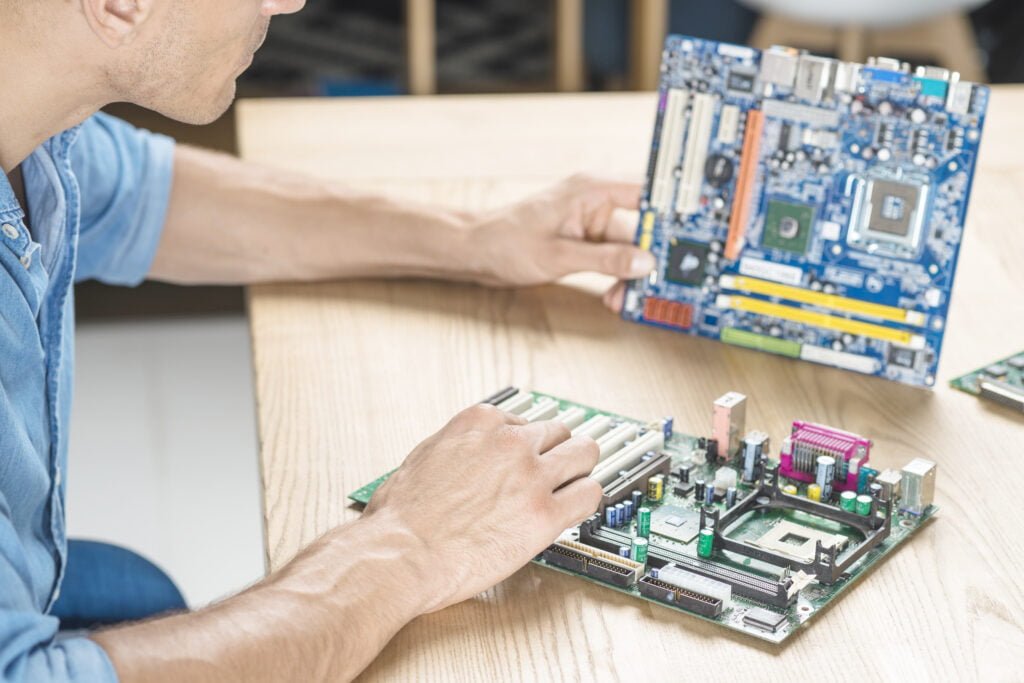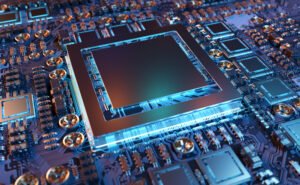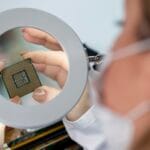A key component of effective product development in today’s fast-paced technology environment is the capacity to quickly translate abstract concepts into physical prototypes. This is where Field-Programmable Gate Arrays (FPGAs) come into play, revolutionizing the way rapid prototyping is done in the world of digital systems. FPGAs are a unique category of reconfigurable integrated circuits that provide unparalleled flexibility and agility when building digital systems.
Fundamentals of FPGA Technology
Modern digital system development relies heavily on Field-Programmable Gate Arrays (FPGAs), which offer a dynamic platform that can be tailored to handle a wide range of activities. One must go into the core technological foundations of FPGAs to fully understand their capabilities and how they operate. This section examines the fundamental components of FPGA technology, illuminating their structure, constituent parts, and configuration procedures.
A. Basic Architecture of FPGAs
A matrix of customizable logic blocks (CLBs) coupled with programmable routing resources defines the architecture of an FPGA. This matrix acts as the building block for digital circuits. Look-up tables (LUTs), flip-flops, multiplexers, and other parts that can be modified to implement logical operations and storage components are included in each CLB.
B. Logic Blocks, Look-Up Tables (LUTs), and Flip-Flops
LUTs, or look-up tables, are the brains of FPGA logic. By customizing the inputs, these tables, which contain predefined truth tables, can implement any logic function. Flip-flops enable sequential logic operations and memory components within an FPGA design by giving users the capacity to store and synchronize digital signals.
C. Programmable Routing Resources
The linking of logic blocks and the transmission of signals between them are made possible by routing resources. These resources are made up of wires and programmable switches that can be set up to make certain connections. Designers can create a variety of signal pathways to meet their unique design requirements because of this versatility.
D. Clock Networks and Global Clock Distribution
A synchronized clock distribution across the chip is ensured by the inclusion of dedicated global clock networks in FPGAs. To develop high-performance systems, it is essential to be able to precisely manage and synchronize the timing of various FPGA components.
E. Configuration Process: SRAM-based vs. Flash-based FPGAs
A bitstream—a binary configuration file—is loaded onto an FPGA during the configuration process. SRAM-based FPGAs are highly reconfigurable but require configuration at starting since they rely on external memory to store the configuration. On the other hand, flash-based FPGAs internally store the configuration, enabling instant startup but with limited reconfigurability.
Rapid Prototyping Methodology
The iterative process of creating digital systems relies heavily on rapid prototyping. The conventional method of testing and validation that simply relies on software simulations has drawbacks and frequently falls short of capturing the subtleties of real-world hardware behavior. Rapid prototyping techniques based on FPGAs start to take shape at this point, providing a practical and dynamic testing environment that bridges the gap between theoretical designs and physical implementations.
A. Traditional Software-Based Simulation vs. FPGA-Based Prototyping
- Limitations of Software Simulations: While software simulations are essential for early-stage design validation, they lack the real-time execution and hardware interactions that hardware prototypes provide.
- Advantages of FPGA-Based Prototyping: FPGA-based prototyping introduces real-world hardware characteristics, enabling accurate performance evaluation, system validation, and software-hardware co-design.
B. Advantages of Hardware Prototyping
- Real-Time Interaction: FPGA-based prototypes execute in real-time, allowing for dynamic interactions and testing under conditions closely resembling the final product.
- Accurate Timing and Latency Analysis: FPGA prototypes facilitate accurate measurement of timing constraints and latency, aiding in identifying potential bottlenecks.
- Early Detection of Design Flaws: Hardware prototypes expose design flaws that might remain hidden in software simulations, facilitating early mitigation.
- Interface Validation: FPGA prototypes enable the testing and validation of interfaces with external devices, sensors, and peripherals.
- Validation of Parallelism and Concurrency: FPGA-based prototyping is ideal for assessing the effectiveness of parallel processing and concurrency in the design.
C. Partitioning Strategies for Mapping Modules onto FPGAs
- Module Decomposition: Breaking down the design into smaller modules that can be mapped onto FPGAs individually.
- Interface Definition: Defining clear interfaces between modules to ensure seamless communication and functionality.
- Resource Utilization: Optimizing the allocation of FPGA resources to maximize performance and minimize resource conflicts.
- Communication Infrastructure: Implementing communication mechanisms between modules, considering factors like latency and bandwidth.
D. Co-simulation and Co-emulation with FPGA Prototypes
- Co-simulation: Integrating software simulations with FPGA prototypes for combined testing of software and hardware.
- Co-emulation: Combining FPGA-based prototypes with simulation models of additional components, such as processors or specialized hardware accelerators.
- Benefits: Co-simulation and co-emulation offer comprehensive testing capabilities, enabling the validation of complex system interactions.
E. Debugging Techniques and Tools for FPGA Prototypes
- Signal Probing: Using specialized tools to probe signals within the FPGA prototype, aiding in diagnosing issues.
- Hardware Debugging Interfaces: Utilizing JTAG and other hardware debugging interfaces for real-time observation and modification of the FPGA’s internal state.
- Visualization Tools: Employing visualization tools to track signal flows, state transitions, and timing relationships.
- Virtual Logic Analyzers: Implementing virtual logic analyzer functionalities to capture and analyze signal traces within the FPGA.
Choosing the Right FPGA for Rapid Prototyping
The right Field-Programmable Gate Array (FPGA) selection is a crucial choice that has a big impact on a rapid prototyping project’s success. Careful attention is required to match the FPGA’s capabilities with the project’s objectives given the wide range of FPGA alternatives offered by different manufacturers, including Xilinx, Intel (previously Altera), Lattice, and more. We will examine the variables that engineers and designers need to take into account when selecting an FPGA for their rapid prototyping requirements in this section.
A. Considerations for FPGA Selection
A comprehensive grasp of the project’s scope, objectives, and technical requirements is essential before starting the FPGA selection process. The decision-making process should be influenced by the following important factors:
Performance Requirements: Determine the required computational power, memory capacity, and I/O bandwidth to ensure the chosen FPGA can meet the performance demands of the target application.
Resource Utilization: Assess the FPGA’s logic cells, memory blocks, and other resources to ascertain whether they align with the complexity of the design.
Power Consumption: Evaluate the FPGA’s power consumption characteristics, particularly if the prototype is intended for portable or energy-efficient applications.
I/O Flexibility: Consider the FPGA’s I/O capabilities and interfaces, ensuring compatibility with external components and peripherals.
Development Tools: Investigate the availability and quality of development tools, including software compilers, debugging utilities, and simulation environments.
Ecosystem and Support: Assess the availability of reference designs, libraries, and online communities that can assist in the development process.
Budget Constraints: Factor in cost considerations, including the FPGA’s price, development board costs, and potential licensing fees for development tools.
B. Evaluation of Resource Capacity and Performance
Performance and resource capacity levels differ amongst FPGA families. While lower-end FPGAs are better suited for smaller projects, higher-end FPGAs offer enormous resources that enable the realization of complicated designs. Check to see if the logic components of the FPGA—such as Lookup Tables or LUTs, Flip-Flops (FFs), DSP blocks, memory blocks, and clock management resources—align with the project’s specifications.
C. Availability of Development Tools and Ecosystem
The ease and efficiency of the prototyping process are significantly influenced by the availability and quality of development tools. Examine the integrated development environment (IDE), synthesis and simulation software tools, and compatibility with popular hardware description languages (HDLs) like Verilog and VHDL of the FPGA manufacturer. Application notes, reference designs, forums, and technical assistance are all components of a strong ecosystem that help development go more smoothly.
D. Comparing Different FPGA Families
Different FPGA manufacturers offer unique device families, each with their advantages and disadvantages. For instance, Intel FPGAs have strong DSP capabilities, whereas Xilinx FPGAs are renowned for their performance and versatility. On the other side, lattice FPGAs have an emphasis on power efficiency and compact form factors. It is critical to assess each family’s distinctive qualities in light of the project’s requirements.
E. FPGA Development Boards and Kits for Rapid Prototyping
A platform for designing, testing, and verifying prototypes is provided by FPGA development boards. The FPGA, RAM, multiple I/O interfaces, and power circuits are often present on these boards. Choose a development board that is compatible with the FPGA of your choice, has the required connectivity choices, and has flexibility for expansion. Additionally, pre-designed reference designs that might speed up the prototype process may be included in development kits.
Conclusion
Field-Programmable Gate Arrays (FPGAs) have become important drivers for rapid prototyping in the field of digital system development, linking the conceptual and physical worlds. This investigation has shown the crucial role that FPGAs play in promoting innovation, providing real-time performance, and facilitating hardware-level validation.
It’s important to carefully examine performance, resources, tools, and ecosystem support when choosing the best FPGA for prototyping. The project’s success and development trajectory are shaped by this decision.
Looking forward, FPGAs will continue to evolve, converging with emerging technologies and reshaping industries. As innovation remains paramount, FPGAs stand as steadfast enablers of transformative ideas, driving us toward a future where imagination and technology intertwine seamlessly.


![What is FPGA Introduction to FPGA Basics [2023] computer-chip-dark-background-with-word-intel-it](https://fpgainsights.com/wp-content/uploads/2023/06/computer-chip-dark-background-with-word-intel-it-300x171.jpg)









